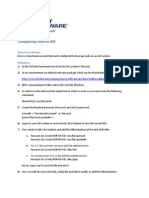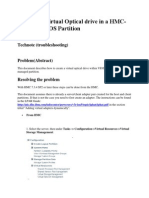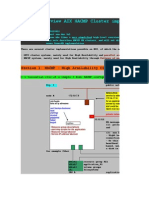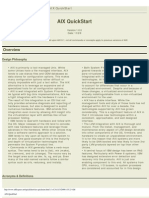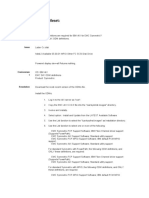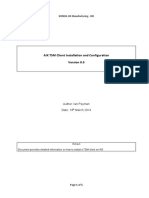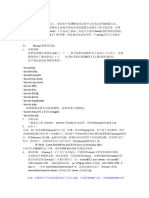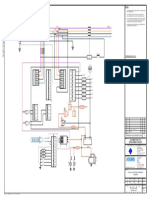AIX PAGING SPACE
AIX PAGING SPACE
# lsps -a Page Space Type hd6 Physical Volume hdisk0 Volume Group rootvg Size %Used Active 512MB 17 yes Auto yes lv
CREATE A NEW LV TO USE FOR PAGING SPACE
# mklv -t paging rootvg 5 pagelv00
SEE CURRENT PAGING SPACES WHICH ARE REGISTERED
# # cat /etc/swapspaces * /etc/swapspaces * * This file lists all the paging spaces that are automatically put into * service on each system restart (the 'swapon -a' command executed from * /etc/rc swaps on every device listed here). * * WARNING: Only paging space devices should be listed here. * * This file is modified by the chps, mkps and rmps commands and referenced * by the lsps and swapon commands. hd6: dev = /dev/hd6
ENABLING A PAGING SPACE
# swapon /dev/pagelv00 # lsps -a Page Space Physical Volume Type pagelv00 hdisk0 hd6 hdisk0 #
Volume Group rootvg rootvg
Size %Used Active 640MB 512MB 1 17 yes yes
Auto no yes lv lv
DISABLING A PAGING SPACE
# swapoff /dev/pagelv00 # lsps -a Page Space Physical Volume Type
Volume Group
Size %Used Active
Auto
�pagelv00 hd6 #
hdisk0 hdisk0
rootvg rootvg
640MB 512MB
0 17
no yes
no yes
lv lv
CREATING A PAGING SPACE THROUGH mkps
# mkps -a -n -s3 rootvg paging00 # lsps -a Page Space Physical Volume Volume Group Size %Used Active Type paging00 hdisk0 rootvg 384MB 1 yes pagelv00 hdisk0 rootvg 640MB 0 no hd6 hdisk0 rootvg 512MB 17 yes MKPS AUTOMATICALLY ADDS PAGING SPACE IN /etc/swapspaces
Auto yes no yes lv lv lv
# cat /etc/swapspaces * /etc/swapspaces * * This file lists all the paging spaces that are automatically put into * service on each system restart (the 'swapon -a' command executed from * /etc/rc swaps on every device listed here). * * WARNING: Only paging space devices should be listed here. * * This file is modified by the chps, mkps and rmps commands and referenced * by the lsps and swapon commands. hd6: dev = /dev/hd6 paging00: dev = /dev/paging00
CHANGING PAGING SPACE INCREASING PAGING SIZE
# lsps -a Page Space Type paging00 pagelv00 hd6 Physical Volume hdisk0 hdisk0 hdisk0 Volume Group rootvg rootvg rootvg Size %Used Active 384MB 640MB 512MB 1 0 17 yes no yes Auto yes no yes lv lv lv
# chps -s 2 paging00 # lsps -a Page Space Type paging00
Physical Volume hdisk0
Volume Group rootvg
Size %Used Active 640MB 1 yes
Auto yes lv
�pagelv00 hd6 #
hdisk0 hdisk0
rootvg rootvg
640MB 512MB
0 17
no yes
no yes
lv lv
DECREASING PAGING SPACE
# chps -d shrinkps: shrinkps: shrinkps: # lsps -a Page Space Type paging00 pagelv00 hd6 # 1 paging00 Temporary paging space paging01 created. Paging space paging00 removed. Paging space paging00 recreated with new size.
Physical Volume hdisk0 hdisk0 hdisk0
Volume Group rootvg rootvg rootvg
Size %Used Active 512MB 640MB 512MB 1 0 17 yes no yes
Auto yes no yes lv lv lv
AIX SYSTEM DUMP
VIEWING A DUMP DEVICE
# sysdumpdev -l primary secondary copy directory forced copy flag always allow dump dump compression /dev/hd6 /dev/sysdumpnull /var/adm/ras TRUE FALSE ON
CREATING A SECONDARY DUMP DEVICE
�# mklv -t jfs2 rootvg 2 fslv03 # sysdumpdev -s /dev/fslv03 primary /dev/hd6 secondary /dev/fslv03 copy directory /var/adm/ras forced copy flag TRUE always allow dump FALSE dump compression ON
SCANNING A DUMP DEVICE
# sysdumpdev -L -S /dev/hd6 0453-019 No previous dumps recorded. Scanning device /dev/hd6 for existing dump. A valid dump was not detected in the dump devices. Scanning device /dev/fslv03 for existing dump. A valid dump was not detected in the dump devices. #
ESTIMATING A DUMP SIZE
# sysdumpdev -e 0453-041 Estimated dump size in bytes: 138621747 #
EXTENDING A DUMP DEVICE
# extendlv fslv03 1 # sysdumpdev -l primary secondary copy directory forced copy flag always allow dump dump compression # #
/dev/hd6 /dev/fslv03 /var/adm/ras TRUE FALSE ON
�Posted by Shivakant Tiwari at 5:32 PM 0 comments Email This BlogThis! Share to Twitter Share to Facebook Share to Google Buzz Links to this post Labels: AIX commands, AIX SYSTEM DUMP, DUMP SIZE TOO SMALL, EXTENDING A DUMP DEVICE, SCANNING A DUMP DEVICE
Tuesday, March 1, 2011
AIX commands
VG COMMANDS
lsvg lsvg -o lsvg rootvg lsvg -l rootvg rootvg lsvg -o |lsvg -il all VGs lsvg -p rootvg rootvg mkvg -s 8 hdisk1 with partition size 8MB mkvg -s 8 -y sivg hdisk1 hdisk1 with partition size 8MB mkvg -s 4 -t 2 -y sivg hdisk1 4 and no of partions 2 * 1016 chvg -a y newvg activated at startup chvg -a n newvg activation at startup chvg -t 2 newvg on vg newvg chvg -Q n newvg reorgvg newvg newvg Display all VGs Display all active VGs Display info about rootvg Display info about all LVs in
Display info about all LVs in
Display info about all PVs in
Create VG with name vgxx on hdisk1
Create VG with name sivg on
Create sivg on hdisk1 with PP size
To cuase VG newvg automatically
To deactivate the automatic
To change maximum no. of PP to 2032
To disable quorum on VG newvg Reorganises PP allocation of VG
extendvg newvg hdisk3 hdisk4 exportvg newvg
Add PV hdisk3 and hdisk4 to VG newvg Exports the VG newvg
�importvg -V 44 -y newvg hdisk2 newvg, and assign major number 44 redcucevg newvg hdisk3 varyoffvg newvg varyonvg newvg syncvg -v sivg in the VG sivg mirrorvg -S -m sivg hdisk2 (-m for exact mirror, -S forbackground mirror)
Import the hdisk2 with name
Remove PV hdisk3 from VG newvg To deactviate VG newvg To activate VG newvg To sync the mirrored LV
To mirror LVs of sivg with hdisk2
unmirrorvg sivg hdisk2 the set.
To remove the mirrored PV from
FS COMMANDS
lsfs filesystems in the /etc/filesystems entry lsfs -q filesystems with detailed info lsfs -a filesystems (default) lsfs -l output in list format lsfs -c output in column format lsfs -v jfs filesystems chfs -a size=24576 /si x 512 bytes blocks (12 MB) chfs -a size=+24576 /si FS /si chfs -m /si /bi from /si to /bi chfs -A /si filesystem si Lists all
List all
To list all
Specify the
Specify the
Lists all jfs
Change size of FS /si to 24576
Add 24576 x 512 byte blocks to
Change the mount point
To auto mount the
�chfs -d account /si /si. ( from /etc/filesystems file) chfs -a splitcopy=/backup -a copy=2 /oracle mirrored filesystem oracle to /backup in read-only mode crfs -v jfs -g testvg -a size=64465 -m /SHIVA jfs in VG testvg of blocksize 64465 crfs -v jfs -d /dev/lv00 -m /SHIVA /dev/lv00 rmfs /SHIVA associated LV rmfs -r /SHIVA point and associated LV defragfs /sifs system /sifs defragfs -q /sifs defrag status of the file system fsck -y n /dev/lv00 associated to /dev/lv00 assuming response "yes" fsck -p /dev/lv00 backup superblock
Remove account attribute of
This will mount the 2nd copy of
Creates FS /SHIVA of type
Create FS /SHIVA of type jfs on device
Deletes FS /SHIVA and
Deletes FS /SHIVA its mount
To defragment the file
Display the current
To fsck the filesystem
To restore superblock from
PV COMMANDS
lspv hdisk0 characteristics of the PV lspv -p hdisk0 hdisk0 lspv -l hdisk0 volumes on PV hdisk0 chpv -v r hdisk1 removing PV without varyon) chpv -v a hdisk1 chpv -c hdisk0 record on PV hdisk0
Display status and
Display
PP usage of
To list all logical
Close the PV (Used while
Open the PV Clear the master boot
�migratepv hdisk2
hdisk1 hdisk2
To move PPs from PV hdisk1 to
migratepv -l silv hdisk1 hdisk2 hdisk2
To migrate LV silv from PV hdisk1 to
LV COMMANDS
lslv -l lv00 LV by PV lslv -p hdisk1 map for hdisk1 chlv -t copy lv00 type chlv -p r lv00 readonly mode rmlv silv rmlv -f silv without user intervention mklv -s n -c 3 silv hdisk1 copies on hdisk1 extendlv silv 5 with 5 LPs mklvcopy -s n lvsi 2 hdisk1 copies mklvcopy lvsi 3 hdisk1 hdisk2 hdisk2 with 3 copies rmlvcopy lvsi 2 hdisk1 from hdisk1 mklv -t jfslog -y log00 newvg 2 VG newvg with 2LPs logform /dev/log00 Display info about
Display LV allocation
To change the lv00 to copy
To change the lv00 to
To remove silv To remove silv
To make LV silv
with three
To extend the LV silv
To mirror LV lvsi on same PV with 2
To mirror LV lvsi on PV hdisk1 and
Will remove one copy of
LV lsvi
To create a jfslog with name log00 on
To format jfslog volume log00
BLV COMMANDS
�bootlist -m normal -o normal mode bootlist -m service -o service mode bootlist -m normal cd0 hdisk0 in normal mode bootlist -m service cd0 rmt0 hdisk0 to cd0,rmt0,hdisk0 in service mode bosboot -ad /dev/hdisk1 mkboot -cd /dev/hdisk1 bootinfo -b disk bootinfo - t boot bootinfo -e boot from tape bootinfo -T bootinfo -s hdisk0 bootinfo -r memory
To see the boot sequence in
To see the boot sequence in
To change boot sequence to cd0,hdisk0
To change boot sequence
To create boot image on PV hdisk1 To clear the boot image Specifies the bootable
Specifies the type of
Check the machine can
To see the machine type To see the size of hdisk0 To see the size of
PAGE SPACE COMMANDS
lsps -a paging spaces lsps hd6 details of the paging space hd6 chps -a y paging00 paging00 chps -a n paging00 paging00 chps -s4 paging00 paging space in 4 LP blocks
To list out all
To display the
To turn on the paging space
To turn off the paging space
To increase the size of the
�mkps -a -n -s4 sivg VG sivg of 4 LP size (-s4) and activate it
To create a paging space on
immediately (-n) and activate it at every restarts rmps paging00 paging00 swapon -a in /etc/swapspaces file swapon /dev/paging00 paging00 To remove the paging space
To invoke all entries
To make available swap space
SYSTEM DUMP COMMANDS
sysdumpdev -l destination sysdumpdev -L previous dump sysdumpstart -p dump device sysdumpstart -s secondary dump device sysdumpdev -p /dev/lv00 sysdumpdev -P -p /dev/lv00 permanently sysdumpdev -s /dev/rmt0 sysdumpdev -z dump occurred To list the current dump
List the details of the
Starts dump in the primary
Starts dump in the
To make lv00 as primary dump device To make lv00 as primary dump device
To make rmt0 as secondary dump device To determine a new system
Device related commands
cfgmgr and installs device software in system cfgmgr -l vscsi0 components connected to the vscsi0 interface To configure devices
To configure the
lscfg config, diagnostics and vital product definition info
To display
�lscfg -l mem0 device mem0 lscfg -l ent* all Ethernet cards lscfg -v lscfg -v -l hdisk0 mkdev -l rmt0 defined state to available state lsdev -P supported devices lsdev -P -c disk disks lsdev -P -r class class lsdev -P -r subclass lsdev -C configured devices lsdev -C -l mem0 mem0 chdev -l sys0 -a maxproc=100 chdev -l rmt0 -a blocksize=512 chdev -l rmt0 -a ret=no rmdev -l rmt0 rmdev -d -l rmt0 totally from database rmdev -l rmt0 -S device stopped lsparent -C -k rs232 devices which accept rs232 devices lsparent -C -l hdisk0 which accept child device hdisk0 lsattr -Dl rmt0 values of the device rmt0 lsattr -El rmt0 values of the device rmt0
Display info about
Display info about
Display vpd Display vpd of hdisk0 To change device rmt0 from
To lists all
To list all supported
To display supported
To display all sub class To lists all
To display the properties of
To change default maxproc value to 100 To change the block size to 512 To avoid tape retension To remove the device rmt0 To remove the device
To change the state of the
To display possible parent
To display parent devices
To see the default
To see the current
�lsattr -El tty0 -a login -R the login attribute of tty0 lsconn -p scsi0 connection scsi0 can accept lvlstmajor major numbers mknod /dev/null c 2 2 (2) and minor (2) nos. (c - char device)
To see all possible values of
To list all possible
To list the available
Create null device with major
Console emulation commands
lscons current console lscons -b at next boot chcons /dev/tty3 tty3 chcons -a login=enable /dev/tty3 login prompt swcons /dev/tty3 tty3 temporarily
To list the
To list the console
To change the console to
Redirect console to tty3 and provide
To change system console to
Installation specific commands
lslpp -l details of installed file sets lslpp -ha bos.net.* history of all file set in bos.net packages lslpp -f bos.rte the bos.rte package lslpp -w /etc/hosts contain /etc/hosts file lslpp -p bos.net.nfs.server bos.net.nfs.server file set To see the
To list the installation
To list the files in
To list the file set which
To list the pre requisites for
�installp -L -d /dev/rmt0.1 on the device rmt0
To list the installable products
installp -aX -d /dev/rmt0.1 bos.net To install all filesets within bos.net and expands file system if it requires installp -u bos.net bos.net installp -r applied software installp -c -f <product> installp -C incomplete installation lppchk -c <product> instfix -k IX9999 -d /dev/rmt0.1 fix IX9999 from rmt0 instfix -ik IX9999 installed To remove
To reject the
To commit the <product> To cleanup an
To check the <product> To install the file set associated with
To verify fix IX9999
Network related commands
host 193.9.200.1 (from /etc/hosts file) host ibm Resolve ibm to ip address (from /etc/hosts file) hostname ibm ibm entstat en0 ethernet device en0 entstat -d en0 status of device en0 no -a configurable attributes and their values no -d thewall parameter to its default value no -o ipforwarding=1 in tcpip networks To change the host name to Resolves ip to host name
To the status of
To list the detailed
To list all net
To change thewall
To make the machine as router
�traceroute ibm ping ibm tcp ping to the machine ibm ifconfig -a all network interfaces ifconfig en0 en0 ifconfig en0 up ifconfig en0 down ifconfig en0 detach network interface list
To trace the route to ibm To
To show the status of
To show the status of
Turns on network card en0 Turns off network card en0 Removes en0 card from the
ifconfig en0 inet 194.35.52.1 netmask 255.255.255.0 up Configure en0 starts immediately ifconfig en0 alias 195.60.60.1 route add 0 192.100.13.7 gateway for entire network route add 192.100.12.0 network route -f gateway table chdev -l inet0 -a hostname=si permanently netstat -a all sockets netstat -c buffers cache netstat -D of packets netstat -i display interface statistics netstat -r table netstat -rn table (ip will be given instead of host names) netstat -s statistics of the protocols 192.100.13.7 Create alias ip address for en0 To make 192.100.13.7 as default
To make 13.7 as gateway for 12.0
To clear the
To change the host name to si
To show the state of
To show the network
To show the net drops
To
To show the routing
To show routing
To show the
�netstat -s -p < tcp/udp/ipv6> respective protocols
To show the statistics of
Space usage commands
du -k bytes in 1k blocks du -l of bytes in 512 bytes blocks du -s total disk usage in the current directory df -i of free and used inodes df -k diskspace in 1024 bytes format To list number of
To list number
To list only the
To display no
To display
Backup commands
mksysb -i -X /dev/rmt0 backup (-X expands /tmp if required) mksysb -m /dev/rmt0 file and system backup
Creates image.data and system
Creates image.data file with map
mksysb -e /dev/rmt0 Creates system data but excludes the files listed in /etc/exclude.rootvg mkszfile file mkcd -d /dev/cd1 system boot backup to the CD-R device /dev/cd1 mkcd -d /dev/cd1 -v vg00 device /dev/cd1 mkcd -d /dev/cd1 -G savevg -i -f /dev/rmt0 vg00 backup vg vg00 Creates Creates /image.data
Creates
backup of vg vg00 to CD-R
Creates
generic boot backup
Creates vg00.data image file and
�savevg -ef /dev/rmt0 vg00 but excludes files listed in the /etc/exclude.vg00
Creates vg00 backup
find / -print | backup -ivf /dev/rmt0 Backup entire system to rmt0 backup -0vf /dev/rmt0 /home backup level 0 restore -Tvf /dev/rmt0 restore -xvf /dev/rmt0 /home rmt0 Backup /home directory to rmt0 with
List the archive in rmt0 Restore /home from archive in device
find ./home -print |cpio -ocvumB > /dev/rmt0 Archives /home directory cpio -icvdumB < /dev/rmt0 cpio -ivt < /dev/rmt0 archive from rmt0 cpio -icvd < /dev/rmt0 /home tar -cvf /dev/rmt0 rmt0 device tar -tvf /dev/rmt0 archives in rmt0 tar -xvf /dev/rmt0 /home dd if=si of=si1 conv=ebcdic ebcdic si1 Extract /home from rmt0 Convert and copy ascii file si to /home Restores cpio archive from rmt0 List the contents of cpio
Restores /home directory from rmt0 Archives /home to
List the
dd if=/dev/rmt0 ibs=512 obs=1024 of=/dev/rmt1 To copy blocks from rmt0 with 512 blocks to rmt1 with 1024 blocks tctl -f /dev/rmt0 rewind tctl -f /dev/rmt0 offline tctl -f /dev/rmt0 status chdev -l rmt0 -a block_size=512 512 To rewind the tape To eject the tape To show the status of tape To change the block size of the tape to
Print commands
qchk -q default q To display the
�qchk -P lp0 of the printer lp0 qchk -# 123 job number 123 qchk -A status of all queues qcan -x 123 123 qcan -X -P lp0 submitted to lp0 qpri -#570 -a 25 the job to 25 qhld # 569 qhld -r -#569 569 qmov -m lpa -#11 enable psq disable psq cancel -#111 lpstat status all queues lpstat -p lp0 of print queue lp0 lpstat -u root submitted by user root lpq -P lp0 status of queue lp0
To display the status
To display the status of
To display the
To cancel the print job
To cancel all jobs
To change the priority of
To hold the
job 569
To remove holding from
To move the job 11 to queue lpa To enable queue psq To disable queue psq To cancel job 111 To display the
To display the status
To display the jobs
To display the
last records in the /var/adm/wtmp file last |grep shutdown uptime (w -u ) system has been up
To list all the
To show the shutdown sessions To show how long the
Licensing commands
�oslevel operating system level lslicense of license chlicense -u30 license to 30 chlicense -f license on
To list the
To see the number
To change the fixed user
To enable floating user
User commands
id id -gn id -Gn
To list all system identifications for current user To list the default group for current user To list all system groups for current user To list the attribute of user root To list the attributes of all users To list the home directory of all users To list all usernames To list the authentication method for all users To list expiry date To check account lock status of all
lsuser root lsuser ALL lsuser -a HOME ALL lsuser -a ALL
lsuser -a auth1 auth2 ALL lsuser -a expires ALL lsuser -a account_locked ALL users chuser -a login=true san chuser -a rlogin=true san
To enable the user san Enable san to login remotely
mkuser si Creates user si with default values in /usr/lib/security/mkuser.defalault mkuser su=false rmuser si rmuser -p si si Create user si without su facility To remove user si To remove user si and his all attributes
�who tty nos and ip numbers who /var/adm/wtmp system startup and shutdowns who -r level who am i /who -m mkgroup dcm chgroup users=u1,u2,u3 dcm rmgroup dcm chauthent authentication methods
List users with
Lists history of login logout
To list the run
To list the current user To create the group dcm To add users u1 u2 and u3 to dcm group
To delete the group dcm To change the
Subsystem Commands
lssrc -a status of all subsystems lssrc -h node1 -a subsystems on foreign host node1 lssrc -s kadmind subsystem kadmind lssrc -g tcpip the subsystem group tcpip mkssys rmssys -s kerberos kerberos chssys -s kerb -s kad to kad startsrc -s kadmin kadmin startsrc -g tcpip group tcpip stopsrc -s kadmin subsystem kadmin To list the
To list the status of all
To list the status of the
To get the status of
To add a subsystem To remove the subsystem
To rename the subsystem kerb
To start the subsystem
To start the subsystem
To stop the
�stopsrc -g tcpip group tcpip refresh -s nfsd subsystem refresh -g tcpip subsystem group
To stop the subsystem
To refresh nfsd
To refresh tcpip
Scheduling commands
crontab -l entries crontab -e entries crontab -l > /si of crontab to /si file crontab -r entries crontab -v time /var/adm/cron/cron.allow cron service /var/adm/cron/cron.deny service at -l jobs scheduled via at command at -r root.dfjdhjdh.21 root.dfjdhjdh.21 /var/adm/cron/at.allow at service /var/adm/cron/at.deny service batch when the system load permits atq joe jobs submitted by user joe
To list the crontab
To edit the crontab
To copies the entries
To remove all crontab
To list the submission
File containing users who allowed
File containing users denied cron
To list the
To remove the scheduled job
File containing users who allowed
File containing users denied at
To run the command
To list all the
�ODM Commands
odmget sm_menu_opt To get the objects from class sm_menu_opt odmget -q "id=licenses" sm_menu_opt To list objects that matches query id=licenses from object sm_menu_opt odmdelete -o sm_menu_opt -q "id=licenses" To delete the entries from class sm_menu_opt which agrees the query id=licenses odmshow sm_menu_opt To show the object class definition odmdrop -o sm_menu_opt To drop sm_menu_opt object class odmchange -o sm_menu_opt -q "id=licenses" file1 To change the attributes from file1
errpt complete summary of report errpt -a detailed report errpt -d H related errors errpt -d S software related errors errpt -a -j 34564423 of error id 34564423
To display
To list complete
To list all hardware
To list all
To list detailed error report
chitab tty002:23:respawn:/usr/sbin/getty /dev/tty To enter the entry tty002:23:respawn:/usr/sbin/getty /dev/tty in inittab
�lssrc -g portmap
To start tcpip
HACMP Commands
logs /tmp/hacmp.out rolling history /var/adm/cluster.log up on this file) Detailed event script output logged in 7 day
High level view of cluster events (No clean
/usr/sbin/cluster/history/cluster.mmdd events. (one file / day of month) /tmp/cm.log /tmp/cspoc.log smit.log) /tmp/emuhacmp.out
Day by day view of cluster
Clstrmgr messages Output from C-SPOC commands (similar to
Output from event emulation
rdist -b -f /etc/disfile1 nodes in disfile1 in binary mode Sample entry for disfile1
To distribute the files in disfile1 to all
HOSTS = ( root@node1 root@node3 ) FILES = ( /etc/passwd /etc/security/passwd) ${FILES} -> ${HOSTS} clstart -m -s -b -i -l daemons (m-clstrmgr, s-clsmuxpd, To start cluster
b-broadcast message, -i-clinfo, -l cllockd) clstop -f -N cluster immediately without releasing resources clstop -g -N shutdown immediately with no takeover clstop -gr -N shutdown immediately with takeover To force shutdown
To do graceful
To do graceful
cldare
-t
To
�sync the cluster toplogy cldare -t -f of topology cldare -r resources cldare -r -f of resources To do the mock sync
To sync the cluster
To do the mock sync
clverify verification utility
cluster
cllscf topology information cllsclstr and security level of the cluster cllsnode about the cluster nodes cllsnode -i node1 cllsdisk -g shrg shared hard disk for resource group shrg cllsnw cluster networks cllsnw -n ether1 network ether1 cllsif details by network adapter cllsif -n node1_service adapter node1_service cllsvg shared vgs which can be accessed by all nodes cllsvg -g sh1 in resource group sh1 cllslv shared lvs cllslv -g sh1 lvs in the resource group sh1 cllsdisk -g sh1 disks in the resource group sh1
To list clustur
To list the name
To list the info
To list info about node1 To list the PVID of the
To list all
To list the details of
To list the
To list the details of network
To list the
To list the shared vgs
To list the
To list the shared
To list the PVID of
�cllsfs shared
To list the file systems To list the shared
cllsfs -g sh1 file systems in the resource group sh1 cllsnim network modules cllsnim -n ether network module cllsparam -n node1 for the node node1 cllsserv application servers
Show info about all
Show info about ether
To list the runtime parameters
To list all the
claddclstr -i 3 -n dcm with name dcm and id 3 claddnode claddnim interface module claddgrp -g sh1 -r cascading -n n1 n2 sh1 with nodes n1,n2 in cascade claddserv -s ser1 -b /usr/start -e /usr/stop server ser1 with startscript as /usr/start
To add a cluster definition
To add an adapter To add network
To create resource group
Creates an application
and stop script as /usr/stop
clchclstr -i 2 -n dcmds name to dcmds and id to 2 clchclstr -s enhanced security to enhanced clchnode parameters clchgrp resource group name or node relationship clchparam parameters (like verbose logging) clchserv of app. server or change the start/end scripts
To change cluster definitions
To change the clustur
To change the adapter
To change the
To change the run time
To change the name
�clrmclstr cluster definition clrmgrp -g sh1 group sh1 and related resources clrmnim ether interface module ether clrmnode -n node1 clrmnode -a node1_svc node1_svc clrmres -g sh1 from resource group sh1 clrmserv app1 server app1 clrmserv ALL servers clgetactivenodes -n node1 cluster manager processes from cluster
To remove the
To delete the resource
To remove the network
To remove the node node1 To remove the adapter named
To remove all resources
To remove the application
To remove all applicaion
To list the nodes with active
manager on node node1 clgetaddr node1 from node node1 clgetgrp -g sh1 resource group sh1 clgetgrp -g sh1 -f nodes nodes in the resource group sh1 returns a pingable address
To list the info about
To list the participating
clgetif name/interface device name/netmask associated with
To list interface
a specified ip label / ip address of a specific node clgetip sh1 associated to the resource group clgetnet 193.9.200.2 255.255.255.0 193.9.200.2, netmask 255.255.255.0 clgetvg -l nodelv nodelv cllistlogs clnodename -a node5 clnodename -o node5 -n node3 To get the ip label
To list the network for ip
To list the VG of LV To list the logs To add node5 to the cluster To change the cluster node name node5 to
�node3 clshowres defined for all resource group clfindres resource group within a cluster xclconfig configuration xhacmpm management xclstat cluster status
Lists resources
To find the
X utility for cluster
X utility for hacmp
X utility for
NIM Commands
nimconfig -a pif_name=en0 -a netname=net1 To initialise the NIM master with network name net1 nimconfig -r variables for NIM To rebuild /etc/niminfo file which contains the
nim -o define -t lpp_source -a source=/dev/cd0 -a server=master -a location=/export/lpp_source/lpp_source1 lpp_source1
To define directory from source cd0
lpp_source1 image in /export/lpp_source/lpp_source
nim -o define -t mksysb -a server=master mksysb1
-a location=/resources/mksysb.image
To define mksysb resource mksysb1, from source /resources/mksysb.image on master
�nim -o remove inst_resource inst_resource nim -o check lpp_source1 lpp_source1
To remove the resource
To check the status of
lpp_source
nim -o allocate -a spot=spot1 -a lpp_source=lpp_source1 node1 To allocate the resources spot1 and lpp_source1 to the the client node1 nim -o bos_inst node1 To initialise NIM for the BOS installation on node1 with the allocated resources nim -o dkls_init diskless operation dcmds To initialize the machine dcmds as
nim -o dtls_init dcmds dataless operation nim -o cust dcmds customize operation nim -o diag dcmds operation nim -o maint dcmds maintenance operation
To initialize the machine dcmds for
To initialize the machine dcmds for
To initialize the machine dcmds for diag
To initialize the machine dcmds for
nim -o define -t standalone -a platform=rspc -a if1="net1 dcmds xxxxx" -a cable_type1=bnc dcmds To define the machine dcmds as standalone with platform as rspc and network as net1 with cable type bnc and mac address xxxxx nim -o unconfig master nim -o allocate -a spot=spot1 dcmds To allocate the resource spot1 from machine dcmds nim -o deallocate -a spot=spot1 dcmds To de allocate the resource spot1 from machine dcmds nim -o remove dcmds To re move machine dcmds after removing all resources associated to it nim -o reboot dcmds To reboot ther client dcmds To unconfigure nim master master
nim -o define -t lpp_source -a location=/software/lpp1 -a server=master -a source=/dev/cd0 lpp1 To define lppsource lpp1 on master at /software/lpp1 directory from source device /dev/cd0
�lsnim list the nim resources lsnim -l dcmds the detailed info about the object dcmds lsnim -O dcmds operation dcmds object can support lsnim -c resources dcmds resources allocated to the machine dcmds To list
To
To list the
To list the
nimclient The client version of nim command (User can obtain same results of nim in server )



















